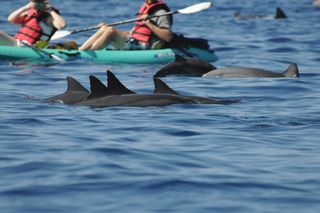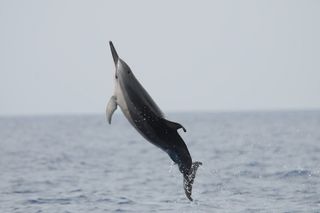Tourists Disturb Dolphins' Sleep

Tourists in Hawaii often jump on a chance to see spinner dolphins up close, kayaking and snorkeling in bays where the marine mammals swim. But human visitors might be depriving the dolphins of much-needed daytime rest.
Spinner dolphins, famous for their aerial acrobatics, spend their days sleeping in shallow, protected bays and their nights feeding in more open waters. Unfortunately, this schedule clashes with tourists' playtime, and researchers warn that daily harassment by humans during periods of rest could have lasting negative impacts.
"Sleep is essential for most animals," marine scientist David W. Johnston, of Duke University, said in a statement. "When deprived of their necessary 'zzzz's,' they gradually show a decreased ability to process information and remain attentive to environmental stimuli. In technical lingo, we call this a 'vigilance decrement.'"
Spinner dolphins that chronically lack sleep might seriously suffer in their ability to find food, avoid predators and communicate with other animals, the researchers said. In an Aug. 27 paper published in the journal PLoS ONE, Johnston and his colleagues at Duke and Stony Book University proposed special maps to help curb some negative effects of human activity, without taking away all tourist opportunities for up-close encounters. [Sleep Tight! Snoozing Animals Gallery]

Their mapping model takes into account key environmental factors that make a bay ideal for sleeping — such as its depth, size and distance from foraging areas — to identify the areas where human activities should be closely monitored. In a study of 99 bays along the western coastlines of the main Hawaiian islands, the researchers found that just 21 were suitable habitats for sleepy dolphins. With this information, the researchers said conservation efforts could be focused on specific areas, rather than limiting access to dolphins along entire coasts.
Johnston told LiveScience in an email that the study follows decades of unregulated interactions between humans and dolphins in Hawaii's bays.
"While we work on understanding how spinner dolphins respond to intensive human presence, we also needed to determine what constitutes appropriate resting habitat so that it can be protected," he added.
Sign up for the Live Science daily newsletter now
Get the world’s most fascinating discoveries delivered straight to your inbox.
Follow LiveScience on Twitter @livescience. We're also on Facebook & Google+.

